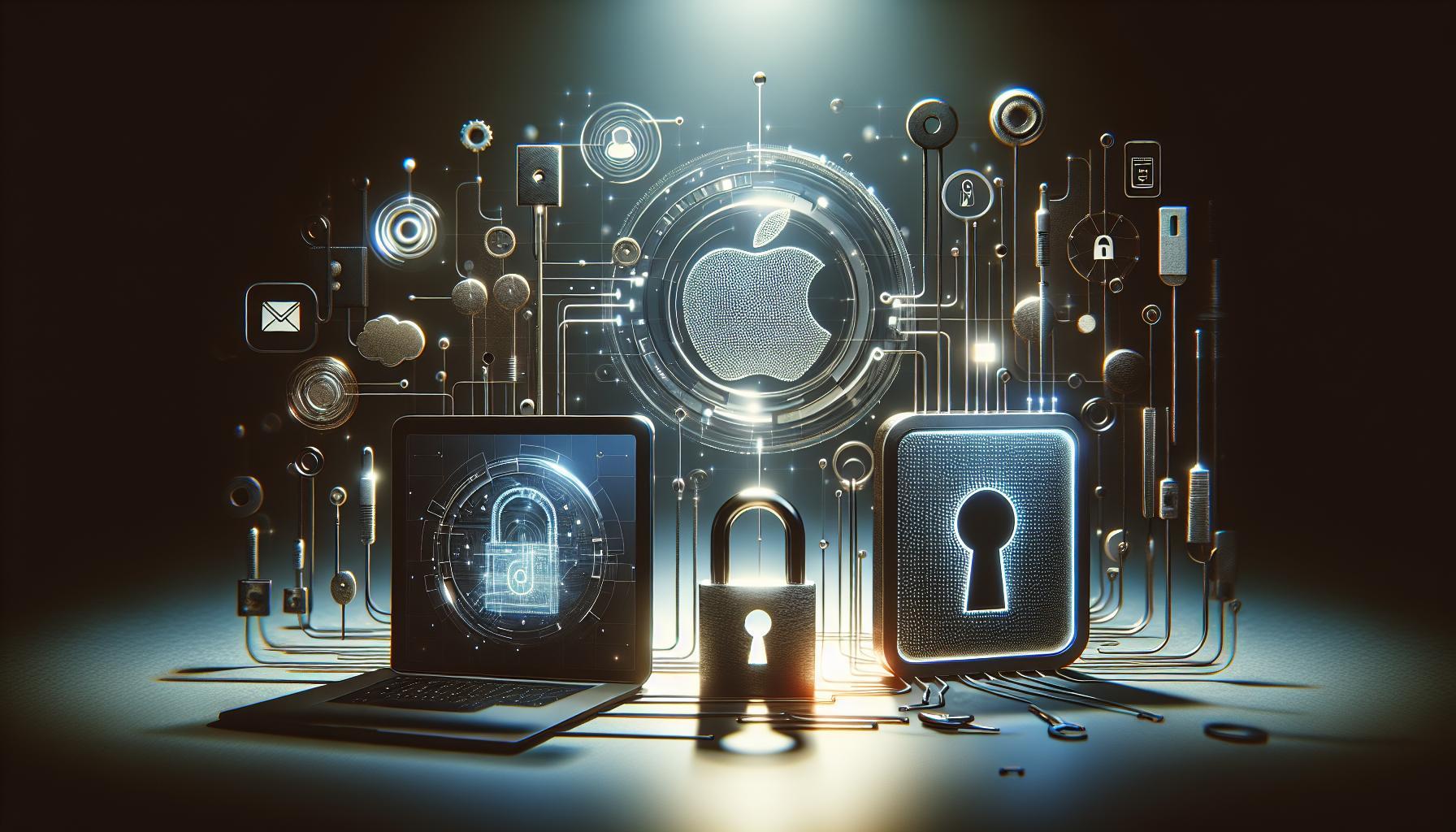Are you struggling to access your Apple account due to a forgotten security.org/how-secure-is-my-password/” title=”How Secure Is My Password? | Password Strength Checker”>password? Changing your Apple ID password is crucial for maintaining account security and regaining full control of your digital life. In this guide, we’ll walk you through the simple steps to reset your password, ensuring that your personal information remains safe and accessible.
Understanding the Importance of Your Apple ID Password
The security of your digital life is often condensed into a single component: your password. Your Apple ID password is not just a mere collection of characters; it serves as the gateway to your entire ecosystem of Apple services,including iCloud,the App Store,Apple Music,and much more. Given the increasing prevalence of cyber threats and identity theft, cannot be overstated.
When you think about the data and assets tied to your Apple account, the stakes become clear. A compromised Apple ID can lead to unauthorized purchases, access to personal information, and even identity theft. To protect yourself, a robust and unique password is essential. Consider updating your password regularly and implementing two-factor authentication, which adds an extra layer of security by requiring a secondary form of verification.
why Changing Your Password Is Crucial
Changing your Apple ID password periodically can significantly reduce the risk of unauthorized access. If you suspect that your account may have been compromised, taking prompt action to change your password is vital. This is especially true if you’ve reused passwords across various platforms, which can make it easier for attackers to gain access.
Here are a few practical actions to enhance your password management:
- Utilize a password manager to store and generate strong passwords.
- Make your password at least 12 characters long, incorporating a mix of uppercase, lowercase, numbers, and symbols.
- Regularly review your account settings for any unauthorized changes or connected devices.
By adopting these strategies, you not onyl safeguard your Apple ID but also take a proactive stance against potential security threats. Remember, the process of how to change your Apple ID password is straightforward, and regaining full control of your account is just a few taps away.
step-by-Step Guide to Changing Your Apple ID Password
Changing your Apple ID password is a crucial step in maintaining the security of your Apple devices and services. With the increasing threats to online security, ensuring that your password is strong and secure not only protects your personal information but also gives you peace of mind.If you’re wondering how to change your Apple ID password, fear not! This guide will walk you through the steps to regain full control over your account effectively.
Steps to Change Your Apple ID Password
To alter your Apple ID password, follow these straightforward steps depending on your device:
- On an iPhone or iPad:
- Open the Settings app.
- Tap your name at the top of the screen.
- Select Password & Security.
- Tap Change Password.
- Enter your current password or device passcode to proceed.
- Choose a new password and confirm it.
- On a Mac:
- Click the Apple menu and select System Preferences.
- Choose Apple ID, then select Password & Security.
- Click Change Password.
- Enter your current password, then provide a new password and confirm it.
- Via the Web:
- Go to the Apple ID account page and sign in.
- Select Security, then click Change Password.
- Provide the necessary information and create your new password.
Choosing a Strong Password
When changing your password, it’s essential to select one that is not only secure but also memorable. A strong password typically includes a mix of uppercase letters, lowercase letters, numbers, and special characters. Aim for a length of at least 12 characters. Avoid common passwords and personal information that can be easily guessed.
| Weak Password Examples | Strong Password Examples |
|---|---|
| 123456 | Gv2@9hZp$1Pq |
| password | |
| JohnDoe123 | T!g3#uLp4Aq%6 |
After your password change, it’s wise to review your security settings, including enabling two-factor authentication, to further enhance your account’s security.By doing so, you’ll protect your data and maintain full control over your Apple ID.
Common Issues When Resetting Your Apple ID Password and How to Solve Them
Resetting your Apple ID password can sometimes feel like navigating a labyrinth. Users frequently encounter issues that can make the process frustrating, which is understandable given the importance of the Apple ID in accessing various services. Many people report that despite following the standard reset procedures, they encounter unexpected hurdles, such as difficulty receiving verification codes or being locked out of their accounts for prolonged periods.
Common Dilemmas and Solutions
One of the most common issues users face is not receiving the verification email or code required to reset their password. This often stems from the email being filtered into a spam or junk folder. To mitigate this, check your spam folder thoroughly and ensure that you are checking the correct email associated with your Apple ID. In cases where the problem persists, it may help to remove any security settings on your email account that could be blocking or filtering messages from Apple.
Another notable hurdle during the password reset process is account recovery. If your account has been locked for security reasons, the recovery process can be daunting and time-consuming. Typically, account recovery takes anywhere from 24 to 72 hours but may vary depending on the specifics of your case[[3]](https://discussions.apple.com/thread/255674377). It’s crucial not to intervene—attempting to reset the password or access the account during the recovery can further delay the process. Instead, refer to official Apple resources for guidance and patience during this phase.
- Keep Your Device Updated: Ensure that your device is running the latest version of iOS, iPadOS, or macOS to avoid any technical glitches during the password reset.
- answer Security Questions Accurately: when prompted to answer security questions, make sure your responses are consistent with what you set during the account creation process.
- Enable Two-Factor Authentication: For enhanced security, enable two-factor authentication on your Apple ID. This provides an additional layer of verification and can definitely help streamline the recovery process.
By preemptively addressing these common barriers, you can maximize your chances of successfully changing your Apple ID password and regaining control over your account more effectively.
Enhancing Your Security: Best Practices After Changing Your Password
Changing your Apple ID password is a crucial step in maintaining your digital security, but it’s just the beginning. Once you’ve taken this vital action, enhancing your security further is essential to protect your personal information from potential threats. With cybercrime on the rise, taking proactive measures can significantly reduce the likelihood of unauthorized access to your accounts.
Monitor Device Security
Promptly after updating your password, monitor all devices linked to your Apple ID for any unusual activity. Make sure that they are running the latest software updates, as these frequently enough include critical security patches. Apple devices come equipped with security features like Password AutoFill, which can alert you if any of your passwords have been marked as weak, reused, or compromised. Regularly change these passwords to ensure they remain secure [[1]](https://support.apple.com/guide/security/password-security-recommendations-sec7f0432063/web).
Enable Two-Factor Authentication
To bolster your account’s defenses, consider enabling two-factor authentication (2FA) if you haven’t already.this feature requires not just your password but also a verification code sent to your trusted devices. It adds an extra layer of security, ensuring that even if someone knows your password, they cannot access your account without the secondary code. You can easily enable 2FA through your Apple ID settings, providing peace of mind and greater control over your account security.
Review Account Recovery Options
as part of strengthening your security posture, review your account recovery options. Ensure that your email addresses and phone numbers linked to your Apple ID are up-to-date. This is crucial not only for receiving verification codes but also for account recovery in case you forget your password. Additionally, familiarize yourself with Apple’s recovery process so that you can quickly regain access if needed.
Regularly Update and Manage Passwords
Lastly, make it a habit to regularly update your passwords for not only your Apple ID but for all accounts. Utilizing a reputable password manager can definitely help you generate and store complex passwords securely. Avoid using the same password across multiple sites, as a compromise on one can lead to breaches on others. A good strategy is to set a schedule for password updates and stick to it, maintaining a vigilant approach to your online security.
By taking these actions following the update of your Apple ID password, you will significantly enhance your digital security and minimize the risk of unauthorized access. These practices not only protect your information but also empower you to regain full control over your online presence.
How to Recover Your Apple ID If You’ve Forgotten your Password
If you find yourself unable to access your Apple ID because you’ve forgotten your password, you’re not alone. This common issue can seem daunting, but Apple’s recovery options are designed to help you regain access quickly and securely. Understanding these steps is crucial for maintaining control over your Apple account and ensuring your personal information remains safe.
Accessing Account Recovery on Your Device
The most straightforward method to initiate account recovery is directly through your device. follow these steps:
- Open the settings app.
- Try to sign in with your Apple ID.
- if prompted, select the option for Forgot Password?.
These actions will redirect you to the account recovery process, allowing you to request a password reset. If you’re using an iPhone or iPad, this will typically require you to verify your identity using security questions or through your trusted devices.
Using a Recovery Contact
If you’ve set up an account recovery contact, this can simplify the process. Your designated contact can assist you in resetting your password. They will share a unique six-digit code with you, which you will need to enter on your device. This code is essential as it confirms your identity to complete the password reset. If you haven’t designated a contact yet, it’s wise to do so as part of your account security measures for the future [[2]](https://support.apple.com/en-us/102641).
final Steps for Password Reset
After you’ve initiated the recovery process, you may receive instructions via email or a security code sent to your trusted devices. Make sure to follow these directions carefully. Here’s a summary of the final steps you might encounter:
- Check your email for a password reset link.
- Follow the prompts to create a new password that is secure and memorable.
- Ensure your new password is unique and different from previous passwords to enhance security.
These steps are not just about regaining access; they’re about securing your information. Regularly changing your password and utilizing recovery options are essential practices suggested in the guide on how to change Apple ID password and regain full control of your account [[3]](https://support.apple.com/en-asia/102656). By staying proactive, you can avoid future access issues and keep your data safe.
Keeping Your Apple ID secure: Tips to Prevent Future Problems
Keeping your apple ID safe is crucial in today’s digital environment, where identities can be easily stolen if not adequately protected. A common concern is the ability for someone to change your Apple ID password using just your device passcode, which might seem convenient but can also pose significant security risks. To safeguard your account and ensure only you have control, consider implementing a series of proactive measures.
Enable Two-Factor Authentication
One of the most effective ways to enhance the security of your Apple ID is by enabling two-factor authentication (2FA). This feature requires not only your password but also a verification code sent to a trusted device whenever there’s an attempt to sign in from a new device.This extra layer of security makes it significantly more challenging for unauthorized users to access your account.
- Go to Settings on your iPhone or iPad.
- Tap your name at the top to access Apple ID settings.
- Select Password & Security.
- Tap on two-Factor Authentication and follow the prompts to enable it.
Regularly Update Your Password
Changing your password regularly is a straightforward strategy to maintain your account’s security.choose a strong, unique password that combines letters, numbers, and symbols to make it tough for others to guess. Moreover, avoid using easily obtainable information such as birthdays or common words. Following a routine of changing your password every few months can help ensure that your Apple ID remains secure against potential breaches.
| Old Password Suggestions | New Password Best Practices |
|---|---|
| Birthday, 123456, Password | A1b2C3!dEf4, #Security2025, YourUniqueName@ |
Keep Your Devices Updated
Ensure that your devices are running the latest versions of iOS, iPadOS, macOS, or tvOS.Software updates frequently enough include critically important security patches that protect your devices from vulnerabilities and exploitation. Regularly checking for updates and installing them immediately is crucial for keeping your apple ID secure.
protecting your Apple ID involves a multi-faceted approach ranging from enabling two-factor authentication to regularly changing your password and keeping your devices updated. By taking these steps, you can significantly reduce the risk of unauthorized access and help ensure that you maintain full control over your Apple ID for years to come.
What to Do If You Suspect Your Apple ID Has Been Compromised
If you suspect that your Apple ID has been compromised, taking immediate action is crucial to protect your personal information and regain control over your account.An increase in suspicious activity, unexpected password changes, or notifications about logins from unknown devices are all red flags that your account may have been hacked. If you find yourself in this situation, follow these steps to secure your account.
Immediate Steps to Take
- Change Your Password: Start by changing your Apple ID password. This is the most critical step in regaining control. Navigate to the Apple ID account page and select ‘Change Password.’ Ensure your new password is strong and unique.
- Enable Two-Factor Authentication: If you haven’t already, enable two-factor authentication (2FA) for your Apple ID. This adds an extra layer of security by requiring a verification code sent to your trusted device when signing in from a new device.
- Check Account Recovery Options: Review your account recovery options, including the email addresses and security questions associated with your Apple ID. Make sure they are up-to-date and secure.
- Sign out of All Devices: Use the Apple ID page to sign out of all devices. This will end any unauthorized sessions and prevent further misuse of your account.
Contact Apple Support
If you’re unable to regain access to your account or if you suspect that recovery methods are failing, reach out to Apple Support for assistance. They can help verify your identity and may offer additional recovery measures tailored to your situation. Be prepared to provide proof of account ownership, which might include details about devices associated with your Apple ID, a recent purchase, or answers to security questions.
Monitor for Unusual Activity
After taking these steps, keep a close eye on your account for any unusual activity. This includes unexpected emails, purchases, or changes in your account settings. If you notice anything suspicious, report it to Apple immediately. For long-term security, it’s wise to regularly update your password and review your account settings to ensure they remain secure.
By following these actionable steps, you can effectively address the complications of a compromised apple ID and protect your sensitive information. For comprehensive guidance on maintaining the security of your Apple ID, refer to resources like “How to change Apple ID password: Regain Full Control” to enhance your understanding and proactive measures.
Q&A
How to change Apple ID password: Regain Full Control?
To change your Apple ID password and regain full control of your account, go to Settings on your device, select [your name], then Password & Security, and choose Change Password. Follow the prompts to enter your current password, and create a new one.
Changing your password helps protect your personal information. When creating a new password,ensure it is indeed unique,at least eight characters long,and combines letters,numbers,and symbols. Regularly updating your password enhances security against unauthorized access.
Can I reset my Apple ID password if I forgot it?
Yes, if you forgot your Apple ID password, you can reset it by selecting “Forgot Apple ID or password?” on the login screen. Follow the on-screen instructions to recover your account using your associated email or security questions.
This account recovery process is essential for securing your Apple ID, especially if you suspect unauthorized attempts to access it. Consider enabling two-factor authentication for additional protection against such issues.
What should I do if I cannot change my Apple ID password?
If you are unable to change your Apple ID password, ensure you are connected to the internet and that your device is updated to the latest software.You may also need to verify your identity through email or security questions.
If the problem persists, you can initiate account recovery via Apple’s support website, where additional steps are provided for regaining access. Always remember to keep your Apple ID recovery information up to date.
Why does my Apple ID keep getting locked?
Your Apple ID may get locked due to multiple unsuccessful sign-in attempts, which is a security measure to protect your account. To unlock it, follow the prompted instructions in the Apple ID management section.
Regularly updating your password and enabling two-factor authentication can help prevent your account from getting locked in the future. Always watch for security alerts regarding your Apple ID.
What is the best way to create a strong Apple ID password?
To create a strong Apple ID password, use at least 12 characters, including a mix of upper and lower case letters, numbers, and special characters. Avoid easily guessed information, such as birthdays or names.
Innovative ideas include using passphrases or a password manager to generate and store complex passwords securely. Regularly updating your password further strengthens your account’s security.
Can I change my Apple ID password on a Mac?
Yes, you can change your apple ID password on a Mac. Click on the Apple menu,select System Preferences,then Apple ID. Choose Password & Security,and select Change Password to proceed.
This method is similar to changing it on an iOS device and maintains a consistent approach across all devices connected to your Apple ID. Always ensure your system is running the latest software for security updates.
How often should I change my Apple ID password?
It’s a good practice to change your Apple ID password every 6 to 12 months. Changing your password regularly enhances your account’s security against unauthorized access.
Along with regular changes, consider changing it immediately if you suspect any suspicious activity, or if you experience login issues. Keeping your password unique to your Apple ID also helps protect your information.
The Way Forward
changing your Apple ID password is a straightforward process that enhances your security and helps you regain control over your account. By following the simple steps outlined in this article—navigating to Settings, selecting your name, and accessing Password & Security—you can easily update your password and protect your personal information. Remember to choose a strong password that combines letters, numbers, and symbols for increased security.
If you have any difficulties or need more assistance, don’t hesitate to explore Apple’s official support pages or reach out to their customer service for help. Taking these proactive steps to manage your Apple ID not only ensures your account is secure but also gives you peace of mind. For further guidance on digital security or to learn more about managing your Apple devices, feel free to dive deeper into our resources. Your online safety is crucial—stay informed and empowered!






